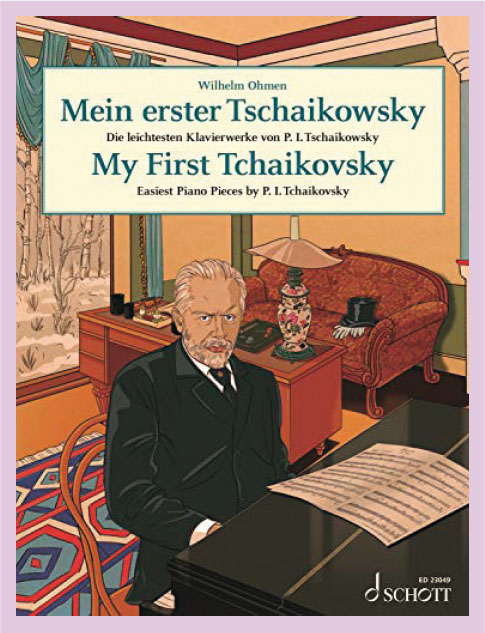
As much as I love teaching adults, my heart sinks when I think about the availability of suitable material for adult beginners. Collections tend to include pieces across a range of different levels – the more technically challenging of which either scare off a nervous beginner, or worse, encourage them to have a go, leading to the development of a multitude of bad habits that can take months to unpick. The Schott My First series is a welcome addition to this market – real music presented in a no-nonsense fashion with all the care and attention one would expect from Schott.
I must confess that when My First Haydn landed on my desk, I was initially sceptical. Despite frequent inclusion on exam lists, Haydn is not a composer who jumps to my mind for piano music. The rather colourful cover illustration of Haydn sat at a cartoon harpsichord, with a kettle drum and a cello propped inexplicably in the corner, did little to encourage my enthusiasm.
My prejudices were immediately allayed on delving into this treasure trove. The repertoire is something of a revelation into the neglected piano repertoire of Haydn. The first part of the folio is made up of a selection of minuets, arranged in a carefully progressive order. The typesetting is delicious – clear and concise without being inflated.
Editorial marks are well considered and exact. Crotchet equals 126 is a delectably precise metronome mark, and it does feel right for this type of early minuet and trio. Likewise, some of the editorial fingering initially appears overly fussy, but it sits under the hand with a surprising fluency. Hats off to Wilhelm Ohmen for some impressive editing.
The next section is given over to German dances, again arranged in a carefully scaffolded order. The folio then gives way to a collection of movements from larger works, including some careful piano transcriptions from the string quartets and symphonies. The collection is rounded off by the duet ‘The Master and His Disciple’. I must confess that this is a new one to me, but I very much enjoyed reading through this light-hearted call-and-response variation set.
The final page is given over to the German national anthem (written by Haydn, in case anyone was wondering at the connection), complete with lyrics. The arrangement is not particularly pianistic, neither does it make a particularly elegant solo piece – although a student reminded me of the time when TV and radio stations used to sign off at night by playing the national anthem, so it makes a nostalgic close to a tasteful folio.
My First Tchaikovsky
My First Tchaikovsky presents an altogether more ambitious collection, again of a composer who I wouldn't immediately turn to for solo piano music. The first half of the book is drawn from Tchaikovsky's Children's Album – a self-confessed Schumann-esque ramble through childhood images, refreshingly lacking in any pedagogical designs. In spite of the title, my young-at-heart student enjoyed working on this beautiful music, which just happens to be accessible to the beginner pianist. For my part, it's refreshing how much learning one can do outside of music consciously designed to teach. We had great fun devising a back story for the hauntingly named miniature ‘The Sick Doll’ (placed rather pessimistically just after ‘The New Doll’ and just before ‘The Doll's Funeral’).
The remainder of the collection is more ambitious: four judicious selections from the aptly named 12 Pieces of Medium Difficulty nestle with three transcriptions from the Nutcracker, and three excerpts from The Seasons. ‘By the Fireside’ and ‘The Lark's Song’ may not be the most familiar of Tchaikovsky's suite, but definitely deserve to be. The ‘fireside’ is invoked alternately by a sonorous, winding hymn tune, and a torrent of harp-like figures. Tchaikovsky finally brings these two elements together, just as the fireside tale dies back down to its embers. The real genius of this piece is in keeping the six sides of narrative intrigue comfortably within the grasp of a Grade 5 pianist.
The final transcriptions, likewise, are thoughtfully pianistic and satisfying both to play and to listen to, in the composer's own arrangements. Why aren't these arrangements printed more often? They have a grace and liquidity which far transcends the clunky finger workouts that have been put in front of me time after time.
Above all, this presents a composer who was a master of colour and sonority; a composer whose solo piano music deserves to be more widely known, and whose sole crime seems to be that so much of his music is reassuringly accessible to pianists, both young and ‘young at heart’.





